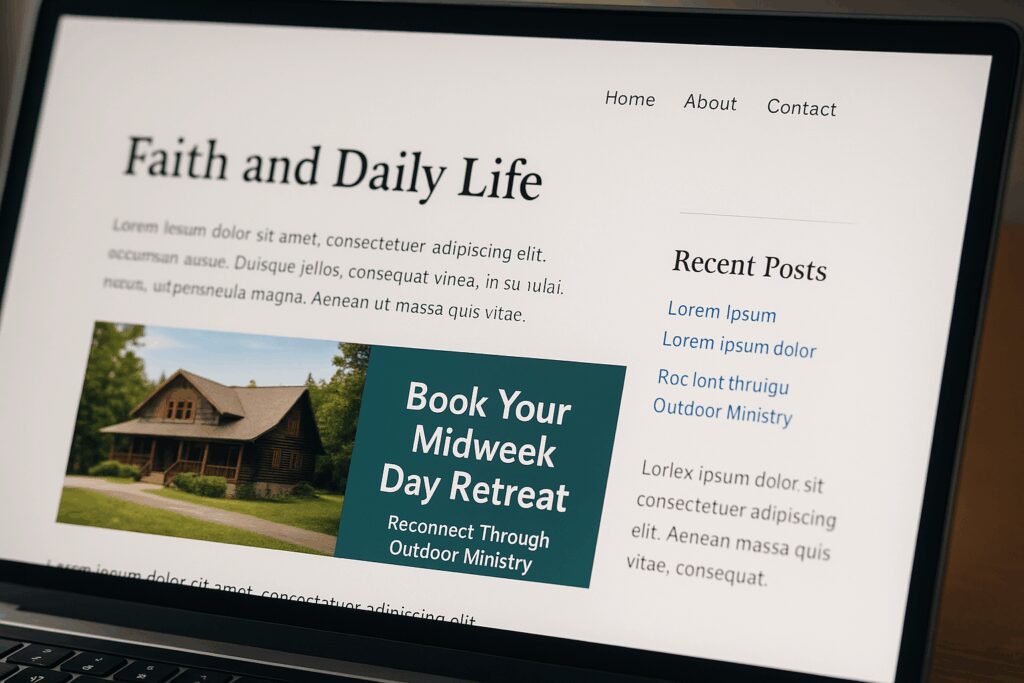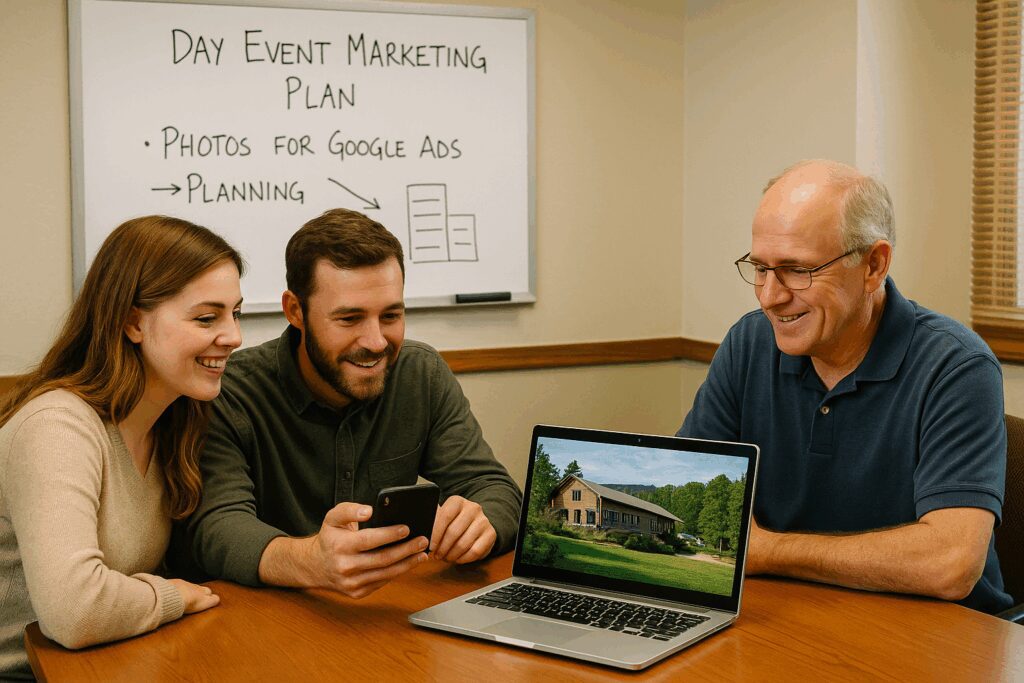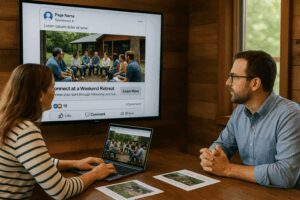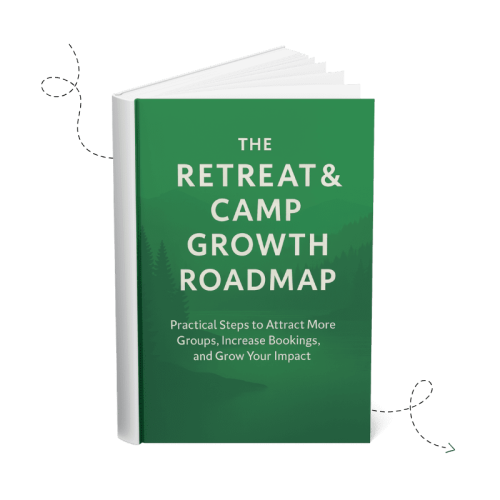Retreat & Camp Growth Roadmap Focus Area: Run Display Ads
Introduction
Display ads are one of the most effective tools for increasing brand visibility online. These are the banner ads you see on websites, YouTube videos, and mobile apps. For retreat centers and camps, display ads offer a way to stay visible to potential guests long before they search for you or land on your website. They’re less about direct response and more about strategic presence—helping your ministry stay top-of-mind in a crowded digital world.
This article will walk you through how display ads work, why they matter, and how to run your first campaign using Google Ads. It’s designed for non-marketers who want to steward their resources well while expanding the reach of their retreat center’s mission.
Why This Focus Area Matters
Most Christian retreat centers and camps have strong referral networks and loyal guests. But even the best programs leave capacity unused during midweek or off-season. Display ads help you expand your reach to mission-aligned audiences who don’t yet know you exist—especially local groups who aren’t actively searching.
By increasing visibility through targeted banner ads, you can:
- Introduce your center to new schools, businesses, and churches
- Promote new offerings like day events or team-building experiences
- Stay top-of-mind with recent website visitors who didn’t book
This is about more than impressions and clicks. It’s about faithful stewardship of your capacity, broadening your ministry reach, and creating new relationships that grow over time.
Is This an Area You Need to Focus on Right Now?
Ask yourself:
- Do we have unused capacity midweek or during the off-season?
- Are we trying to reach people outside of our current referral network?
- Are our current marketing efforts focused mostly on overnight retreats?
- Do we want to increase local awareness of our facilities or day-use offerings?
- Would retargeting help us stay visible to recent website visitors?
If you answered “yes” to any of these, this focus area can help you build long-term visibility and trust with new audiences.
Putting This Focus Area into Practice
Understand What Display Ads Do Best
Display ads are primarily visual banners shown across websites, YouTube, and mobile apps. Unlike search ads, which respond to someone actively looking for a retreat, display ads introduce your center to the right people while they’re going about their day online.
Think of display ads like digital billboards. You’re not catching someone with their hand raised—you’re planting a seed.
Set a Clear, Mission-Aligned Goal
What are you trying to accomplish?
- Raise awareness for a new day-use program?
- Drive more local traffic to your activities page?
- Re-engage website visitors who didn’t inquire?
Each campaign should have one clear goal. Start with brand awareness or retargeting. Your goal shapes your targeting, message, and how you evaluate success.
Build Smart Targeting Audiences
Google Ads gives you several powerful options:
- Demographics: Age, gender, parental status
- Affinity Audiences: Reach people interested in outdoor activities, youth ministry, or team building
- In-Market Audiences: Reach people actively researching group retreats or field trips
- Custom Audiences: Target users who visit similar websites or use related keywords
- Placements: Choose specific websites, apps, or YouTube channels
- Remarketing: Reconnect with people who have visited your site but haven’t booked
Layer your targeting: for example, combine geography + in-market interests to narrow your reach and steward your spend.
Create Display Ads That Reflect Your Mission
Strong ad creative makes all the difference. Focus on:
- Real photos of your facilities or guests
- Headlines that speak to rest, renewal, and connection
- Simple CTAs like “Plan a Day Retreat” or “Explore Activities”
Use responsive display ads to let Google test different headline and image combinations. These ads are easy to set up and allow Google to automatically find the best-performing versions. However, if you want full control over branding, layout, or placement of elements, uploaded banner ads might be a better fit—even though they require more design effort. This is an efficient way to discover which combinations perform best without needing a designer. If you have branding requirements or want more control, uploaded banner ads give you full creative flexibility.

Steward Your Budget with Purpose
You don’t need a massive budget to get started. Many camps and retreat centers see results from $5–$20/day campaigns.
Start small. Run one campaign with a focused audience for 2–3 weeks. Watch performance, then optimize. Avoid spreading your budget too thin.
Track the Metrics That Actually Matter
Don’t get caught up in vanity metrics—think of them like the applause at a conference. It feels good, but it doesn’t always mean people will sign up for your next event. Instead, look for meaningful engagement: people who click through, visit key pages, or start an inquiry. These are the signs that your message is making a real connection. like likes or impressions alone. Focus on:
- Impressions: Are the right people seeing your ad?
- Click-through rate (CTR): Are people interested in learning more?
- Conversions: Are they taking action once they visit your site?
It’s better to have 100 deeply interested visitors than 1,000 casual views. For example, if 30 people click through and 10 visit your booking page, that’s a strong signal of intent.
Plan to review your performance metrics weekly. This helps you track trends, refine your creative, and reallocate your budget to the campaigns that work best.
You may not see bookings immediately, but if engagement is strong, you’re building momentum.
Display Ad Campaign Planning Worksheet
Running display ads may seem complex, especially if you’re just getting started. That’s why we’ve created a practical planning worksheet specifically for retreat centers and camps. Whether you’re launching your first awareness campaign or refining your current strategy, this worksheet will walk you through the most important decisions you’ll need to make to build a focused, high-impact display campaign.
Use this worksheet to:
- Clarify your campaign’s goal and audience
- Write mission-aligned, compelling ad messaging
- Choose the best visuals for your display ads
- Define where you want to send ad traffic (landing page)
- Set a reasonable daily budget and timeline
- Establish how you’ll measure success and what to optimize
📥 Download the Display Ad Campaign Planning Worksheet
This tool is designed to give you clarity and confidence so you can start with purpose and adjust with insight. Use it to build a campaign that reflects your values while expanding your reach.
Mini Case Study
A Christian retreat center we partner with had filled most of their weekends through years of intentional marketing. But midweek capacity remained underutilized, especially during shoulder seasons. While they had some success booking local day events for schools and organizations, awareness outside of word-of-mouth was limited.
They launched a Google Display campaign to promote their outdoor activities and team-building offerings. By targeting local schools and businesses through custom audiences and interest categories, they reached people who were previously unaware of their day-use options.
They integrated their booking system with Google Analytics to track conversions, feeding that data into Google Ads to measure campaign ROI. While not every campaign performed equally, they learned which audiences and creatives drove real inquiries. Over time, they optimized spend toward the highest-performing campaigns—increasing bookings while reducing cost per lead. As a result, they significantly improved local visibility and filled more of their midweek availability.
Putting It All Together
You don’t have to be a digital expert to run effective display ads. You just need a clear goal, a message rooted in your mission, and a willingness to test and learn.
Key Takeaways:
- Use display ads to build brand awareness and stay visible to the right people
- Start with one focused campaign with a clear goal
- Use real imagery and authentic messaging
- Layer your targeting to maximize impact
- Track impressions, clicks, and conversions—not just bookings

Ready to Take the Next Step?
Display ads aren’t about chasing clicks—they’re about being a faithful presence online where the right people are already spending time. With the right message and a clear plan, you can plant seeds today that turn into bookings tomorrow.
If you found this helpful, here are four great next steps to continue your journey:
🧭 Move to the Next Focus Area: Deploy Video Ads
Launch YouTube and short-form video ads to build awareness and reinforce your message visually.
[Read the Deploy Video Ads Focus Area Article]
📘 Download the Retreat & Camp Growth Roadmap eBook
Get the full 3-stage system we use to help retreat centers and camps grow with clarity and purpose.
[Download the eBook]
🌱 Learn More About How We Help Retreat Centers & Camps
We’re a Christian-owned digital marketing agency that helps retreat centers and camps grow attendance, bookings, and impact through practical strategies rooted in clarity and stewardship.
[See How We Can Help]
🤝 Schedule a Free Discovery Call
Want help applying this to your unique situation? Let’s talk. We’ll explore where you are now, where you want to go, and how to take the next faithful step.
[Book a Discovery Call]
You don’t have to figure this out alone. Let’s build something meaningful—together.
Frequently Asked Questions
1. What’s the difference between display ads and search ads?
Search ads appear when someone types in a query on Google, like “Christian retreat near me.” Display ads appear visually across other websites, even if the person isn’t actively searching—helping you build awareness.
2. Where will our display ads actually show up?
They can appear on a vast network of websites, mobile apps, and YouTube. You can also choose specific placements if you want more control.
3. Do we need a designer to create our ads?
Not necessarily. Google’s responsive display ads allow you to upload photos and text, and it builds different versions automatically. But if you have a designer, you can upload custom banners for full creative control.
4. How do we target the right people?
Use a mix of Google’s audience tools: geographic targeting, affinity groups, custom audiences, and retargeting. The key is to define who you want to reach and layer your targeting to match.
5. What kind of results should we expect?
Expect gradual increases in visibility, engagement, and eventually bookings. Look for steady impressions and click-throughs as signs your ads are resonating.
6. Can we use display ads to stay in front of past visitors?
Yes. Remarketing is one of the most effective uses of display ads. You can show tailored ads to people who visited your site but didn’t inquire or book.
7. How much should we budget to get started?
Start with $5–$20/day. Test one audience and one message. Let the campaign run for at least 2–3 weeks before evaluating results.
8. Should we run display and social ads at the same time?
Yes, if your budget allows. They work well together. Social builds engagement, while display builds broad visibility and marketing reach.
9. Do we need a Google Ads expert to manage this?
Not to start. You can run basic campaigns yourself using Google’s guided setup. But if you want faster results or greater efficiency, a retreat marketing agency can help.
10. How do we measure if our campaign is working?
Track impressions, CTR, and conversions weekly to identify trends and make informed adjustments. Regular reviews help you improve performance over time and focus your budget on what’s working.. Use Google Analytics to monitor on-site behavior weekly. And always align your metrics to your original campaign goal.
11. Can we use a Google Ad Grant to run display ads?
Yes, but only recently. Historically, Google Ad Grants could not be used for display ads. However, with the introduction of Performance Max campaigns, nonprofit advertisers can now run brand awareness campaigns that include image and video creatives. This means you can reach a broader audience across Google’s display network while still using your grant budget—just be sure your campaigns align with Google’s Ad Grant policies and focus on mission-driven messaging.
12. Do we need an agency to help build and run our display ads?
Not necessarily—but it depends on your internal capacity and experience. If you have a dedicated staff member with digital marketing knowledge and time to learn, you can absolutely get started in-house. However, managing display ads well requires thoughtful strategy, proper targeting, creative testing, and ongoing optimization. If that feels overwhelming, working with an experienced agency can help you avoid common pitfalls, improve performance, and maximize your return on investment.
For retreat centers and camps, it’s especially important to choose an agency that understands your mission and has demonstrated success helping similar organizations grow through display advertising. The right camp marketing partner will bring not just technical skill, but also alignment with your values and ministry goals.





